Developed Brinkman Model into a Porous Collector for Solar Energy Applications with a Single-Phase Flow
Abstract
:1. Introduction
2. Model Description
3. Governing Equations
4. Results and Discussion
4.1. Validation
4.2. Grid Sensitivity Analysis
4.3. Results and Discussion
5. Conclusions
- –
- The comparison between the non-temporal temperature variations with the experimental results in [5] shows good agreement, with maximum errors of 3%.
- –
- –
- Under constant permeability, the velocity decreases by decreasing the porosity. This is due to the presence of porosity in the collector, where the flow accelerates in the porous collector.
- –
- By increasing the porosity coefficient, the velocity into the boundary layer decreases, and as a result, the thickness of the boundary layer is also decreased.
- –
- In high porosity, according to the definition of porosity, which is the ratio of empty volume to total volume, the empty holes for fluid flow increase, the fluid acceleration is lower, and, therefore, the maximum speed of the ratio of the lower porosity coefficient will be lower.
- –
- The porosity and permeability effects on the pressure drop along the collector are in accordance with a linear relationship that decreases with the increasing porosity and permeability of the pressure drop.
- –
- According to the results, the drop in the pressure inside the porous collector increases closer to the porous collector, which results in higher thermal energy for faster pumping of the high-energy fluid and improves the heat transfer of the solar heat into the collector.
- –
- With increasing pressure due to the porosity in the porous collector, it is possible to increase the temperature of the fluid without changing the phase in the porous collector.
- –
- In the concentration distribution, coupled with developed Brinkman momentum equation, the gradient concentration is determined by the shear stress term near the wall.
Author Contributions
Funding
Institutional Review Board Statement
Informed Consent Statement
Data Availability Statement
Conflicts of Interest
Nomenclature
| P | Pressure | |
| v | Velocity | |
| u | Darcy’s velocity | |
| T | Temperature | |
| CP | Heat capacity in constant pressure | |
| H | Height of the collector | |
| h | Convection heat transfer coefficient | |
| Nu | Nusselt number | |
| q″ | Heat flux | |
| K | Permeability | |
| k | Conduction heat transfer coefficient | |
| L | Length of the collector | |
| X | Length | |
| Concentration | ||
| τF | Effective mass diffusivity coefficient | |
| Fluid diffusivity coefficient | ||
| Dispersion coefficient | ||
| Total diffusivity coefficient | ||
| Greek symbols | ||
| ρ | Density | |
| μ | Dynamic viscosity | |
| ε | Porosity coefficient | |
| ∇ | Gradient | |
| w | ||
| in | ||
| eff | ||
| p |
References
- Bars, M.L.; Worster, M.G. Interfacial conditions between a pure fluid and a porous medium: Implications for binary alloy solidification. J. Fluid Mech. 2006, 550, 149–173. [Google Scholar] [CrossRef] [Green Version]
- Bayomy, A.M.; Saghir, M.Z. Experimental study of using c-Al2O3–water nanofluid flow through aluminum foam heat sink: Comparison with numerical approach. Int. J. Heat Mass Transf. 2017, 107, 181–203. [Google Scholar] [CrossRef]
- Boomsma, K.; Poulikakos, D. On the elective thermal conductivity of a threedimensionally structured ¯uid-saturated metal foam. Int. J. Heat Mass Transf. 2001, 44, 827–836. [Google Scholar] [CrossRef]
- Nield, D.A.; Bejan, A. Convection in Porous Media; Springer: New York, NY, USA, 2006. [Google Scholar]
- Dukhan, N.; Chen, K.-C. Heat transfer measurements in metal foam subjected to constant heat flux. Exp. Therm. Fluid Sci. 2007, 32, 624–631. [Google Scholar] [CrossRef]
- Dukhan, N.; Ratowski, J. Convection Heat Transfer Analysis for Darcy Flow in Porous Media: A New Two-Dimensional Solution. In Proceedings of the International Heat Transfer Conference, Washington, DC, USA, 8–13 August 2010; pp. 865–871. [Google Scholar] [CrossRef]
- Furman, E.L.; Finkelstein, A.B.; Cherny, M.L. Permeability of Aluminium Foams Produced by Replication Casting. Metals 2013, 3, 49–57. [Google Scholar] [CrossRef] [Green Version]
- Guo, L.; Yu, J. Dynamic bending response of double cylindrical tubes filled with aluminum foam. Int. J. Impact Eng. 2011, 38, 85–94. [Google Scholar] [CrossRef]
- Hamdan, M. Single-phase flow through porous channels a review of flow models and channel entry conditions. Appl. Math. Comput. 1994, 62, 203–222. [Google Scholar] [CrossRef]
- Lu, W.; Zhao, C.Y.; Tassou, S.A. Thermal analysis on metal-foam filled heat exchangers. Part I: Metal-foam filled pipes. Int. J. Heat Mass Transf. 2006, 49, 2751–2761. [Google Scholar] [CrossRef]
- Mancin, S.; Zilio, C.; Diani, A.; Rossetto, L. Experimental air heat transfer and pressure drop through copper foams. Exp. Therm. Fluid Sci. 2012, 36, 224–232. [Google Scholar] [CrossRef]
- Rezapour, M.; Fanaee, S.A. Thermal and fluid effects modeling of porous medium on hydrogen mixture with COMSOL. In Proceedings of the Hydrogen and Fuel Cell Conference, Tehran, Iran, 9 May 2017. [Google Scholar]
- Nakayama, A.; Shenoy, A.V. Combined forced and free convection heat transfer in power-law fluidsaturated porous media. Appl. Sci. Res. 1993, 50, 83–95. [Google Scholar] [CrossRef]
- Özgümüş, T.; Mobedi, M.; Özkol, Ü.; Nakayama, A. Thermal Dispersion in Porous Media—A Review on Approaches in Experimental Studies. In Proceedings of the 6th International Advanced Technologies Symposium, Elazığ, Turkey, 16–18 May 2011. [Google Scholar]
- Pankaj, M.; Malipatil, A.S. Experimental Investigation of Pressure Drop & Heat Transfer Coefficient for Aluminium Metal Foams. IOSR J. Mech. Civ. Eng. 2016, 13, 33–38. [Google Scholar] [CrossRef]
- Fanaee, S.A.; Rezapour, M. Analysis of the Fluid-Thermal Regime with the Developed Brinkman Model in a Porous Coil for Solar Energy Application. Modares Mech. Eng. 2019, 19, 855–863. [Google Scholar]
- Zhong, W.; Xu, K.; Li, X.; Liao, Y.; Tao, G.; Kagawa, T. Determination of pressure drop for air flow through sintered metal porous media using a modified Ergun equation. Adv. Powder Technol. 2016, 27, 1134–1140. [Google Scholar] [CrossRef]
- Yang, C.; Nakayama, A. A synthesis of tortuosity and dispersion in effective thermal conductivity of porous media. Int. J. Heat Mass Transf. 2010, 53, 3222–3230. [Google Scholar] [CrossRef]
- Diersch, H.J.G. Finite Element Modeling of Flow, Mass and Heat Transport in Porous and Fractured Media; Springer: Berlin/Heidelberg, Germany, 2014. [Google Scholar]
- Xu, H.; Zhao, C.; Vafai, K. Analytical study of flow and heat transfer in an annular porous medium subject to asymmetrical heat fluxes. Heat Mass Transf. 2017, 53, 2663–2676. [Google Scholar] [CrossRef]
- Dushin, V.R.; Nikitin, V.F.; Legros, J.C.; Silnikov, M.V. Mathematical modeling of flows in porous media. WSEAS Trans. Fluid Mech. 2014, 9, 116–130. [Google Scholar]
- Nakayama, A.; Shenoy, A.V. Non-Darcy Forced Convective Heat Transfer in a Channel Embedded In a Non-Newtonian Inelastic Fluid-Saturated Porous Medium. Can. J. Chem. Eng. 1993, 71, 168–173. [Google Scholar] [CrossRef]
- Cummins, B.M.; Chinthapatla, R.; Ligler, F.S.; Walker, G.M. Time-Dependent Model for Fluid Flow in Porous Materials with Multiple Pore Sizes. Anal. Chem. 2017, 89, 4377–4381. [Google Scholar] [CrossRef]
- Fanaee, S.A.; Rezapour, M. The Modeling of Constant/Variable Solar Heat Flux Into a Porous Coil With Concentrator. J. Sol. Energy Eng. 2019, 142, 1–12. [Google Scholar] [CrossRef]
- Zehforoosh, A.; Hossainpour, S.; Tahery, A.A. Numerical Investigation of Forced Convection Heat Transfer for Laminar Flow in Various Parallel Porous Channels. Int. J. Innov. Manag. Technol. 2010, 1, 252. [Google Scholar]
- Dukhan, N.; Bağcı, Ö.; Özdemir, M. Thermal development in open-cell metal foam: An experiment with constant wall heat flux. Int. J. Heat Mass Transf. 2015, 85, 852–859. [Google Scholar] [CrossRef]
- Zafariyan, S.; Fanaee, A.; Mohammadzadeh, A. The Investigation of Thermal and Solutal Secondary Effects on MHD Convective Transfer Past a Vertical Surface in a Porous Medium. Arab. J. Sci. Eng. 2013, 38, 3211–3220. [Google Scholar] [CrossRef]
- Zafariyan, S.; Fanaee, S.A. MHD Mixed Convective Flow Past a Vertical Plate Embedded in a Porous Medium with Radiation Effects and Convective Boundary Condition Considering Chemical Reaction. Cankaya Univ. J. Sci. Eng. 2013, 10, 123–136. [Google Scholar]
- Ferchichi, S.; Kessentini, H.; Morales-Ruiz, S.; Rigola, J.; Bouden, C.; Oliva, A. Thermal and fluid dynamic analysis of Direct Steam Generation Parabolic Trough Collectors. Energy Convers. Manag. 2019, 196, 467–483. [Google Scholar] [CrossRef]
- Rezapour, M.; Gholizadeh, M. Analysis of methanol thermochemical reactor with volumetric solar heat flux based on Parabolic Trough Concentrator. Renew Energy 2021, 180, 1088–1100. [Google Scholar] [CrossRef]
- Yang, S.; Ordonez, J. 3D thermal-hydraulic analysis of a symmetric wavy parabolic trough absorber pipe. Energy 2019, 189, 116320. [Google Scholar] [CrossRef]
- Deymi-Dashtebayaz, M.; Rezapour, M. The effect of using nanofluid flow into a porous channel in the CPVT under transient solar heat flux based on energy and exergy analysis. J. Therm. Anal. Calorim. 2020, 145, 507–521. [Google Scholar] [CrossRef]
- Deymi-Dashtebayaz, M.; Rezapour, M.; Farahnak, M. Modeling of a novel nanofluid-based concentrated photovoltaic thermal system coupled with a heat pump cycle (CPVT-HP). Appl. Therm. Eng. 2021, 201, 117765. [Google Scholar] [CrossRef]
- Bårdsgård, R.; Kuzmenkov, D.M.; Kosinski, P.; Balakin, B.V. Eulerian CFD model of direct absorption solar collector with nanofluid. J. Renew Sustain. Energy 2020, 12, 033701. [Google Scholar] [CrossRef]
- Huang, G.; Wang, K.; Curt, S.R.; Franchetti, B.; Pesmazoglou, I.; Markides, C.N. On the performance of concentrating fluid-based spectral-splitting hybrid PV-thermal (PV-T) solar collectors. Renew Energy 2021, 174, 590–605. [Google Scholar] [CrossRef]
- Alves, P.; Fernandes, J.F.; Torres, J.P.N.; Branco, P.C.; Fernandes, C.; Gomes, J. From Sweden to Portugal: The effect of very distinct climate zones on energy efficiency of a concentrating photovoltaic/thermal system (CPV/T). Sol. Energy 2019, 188, 96–110. [Google Scholar] [CrossRef]
- Ravanbakhsh, M.; Deymi-Dashtebayaz, M.; Rezapour, M. Numerical investigation on the performance of the double tube heat exchangers with different tube geometries and Turbulators. J. Therm. Anal. Calorim. 2022, 147, 11313–11330. [Google Scholar] [CrossRef]

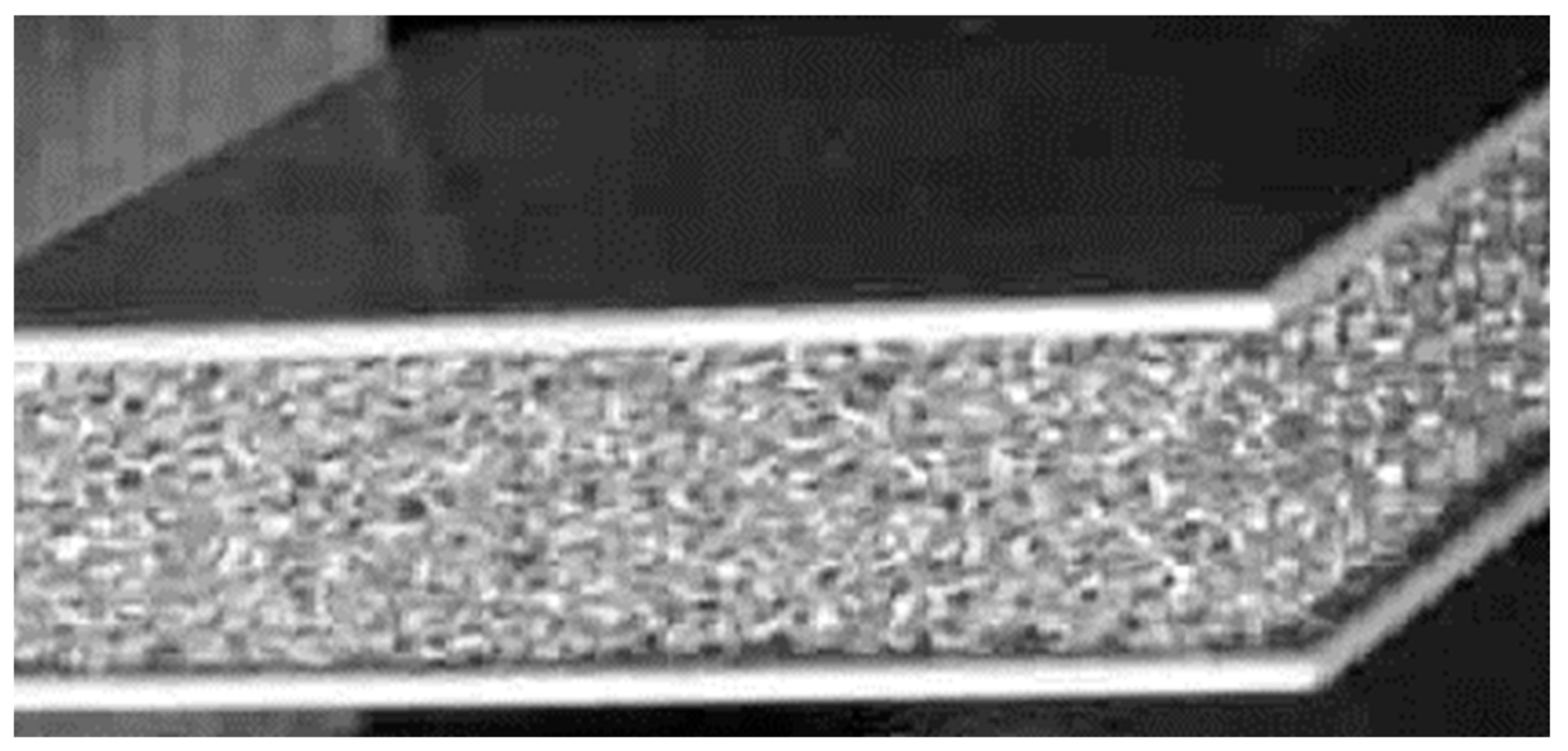
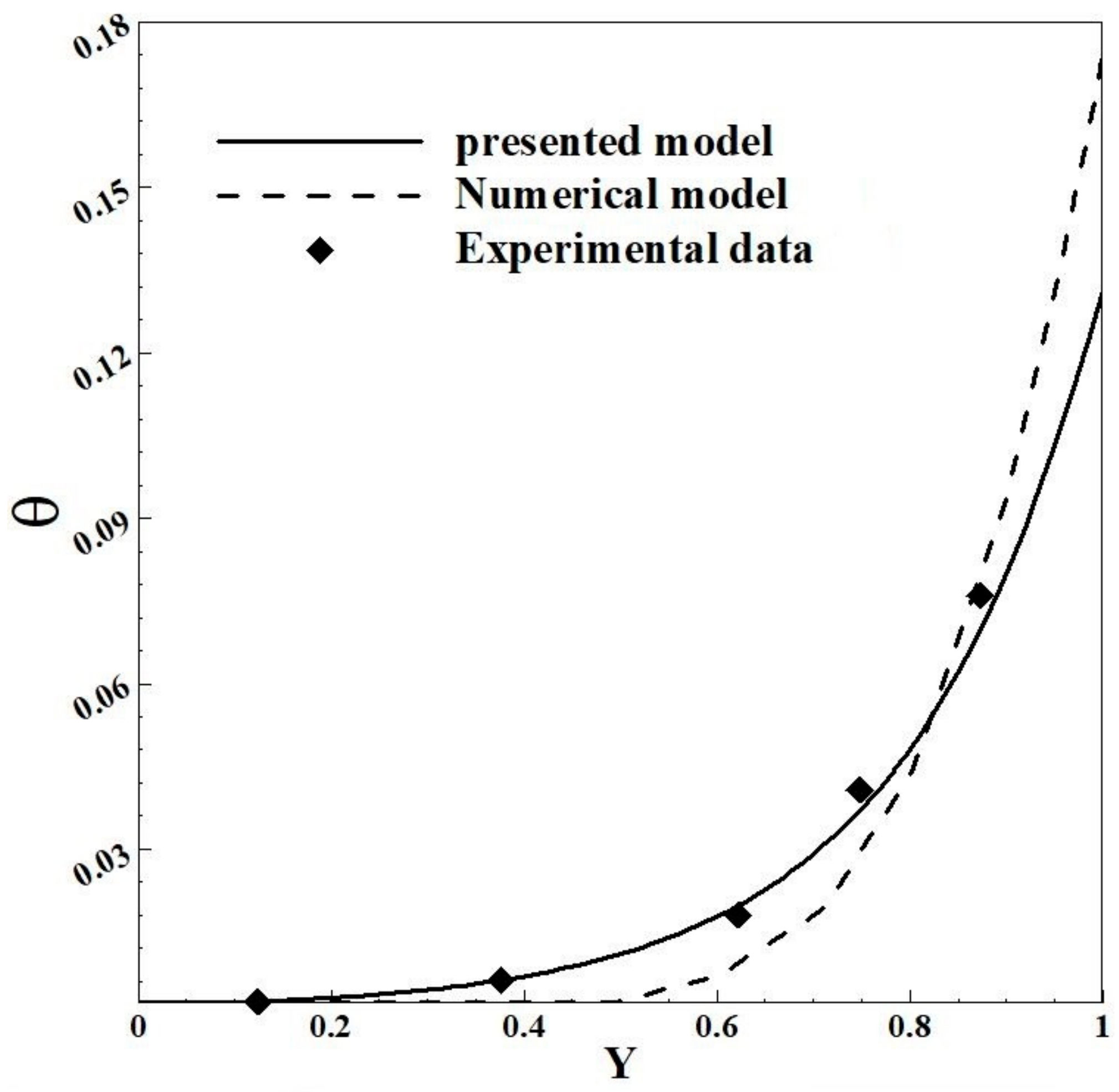
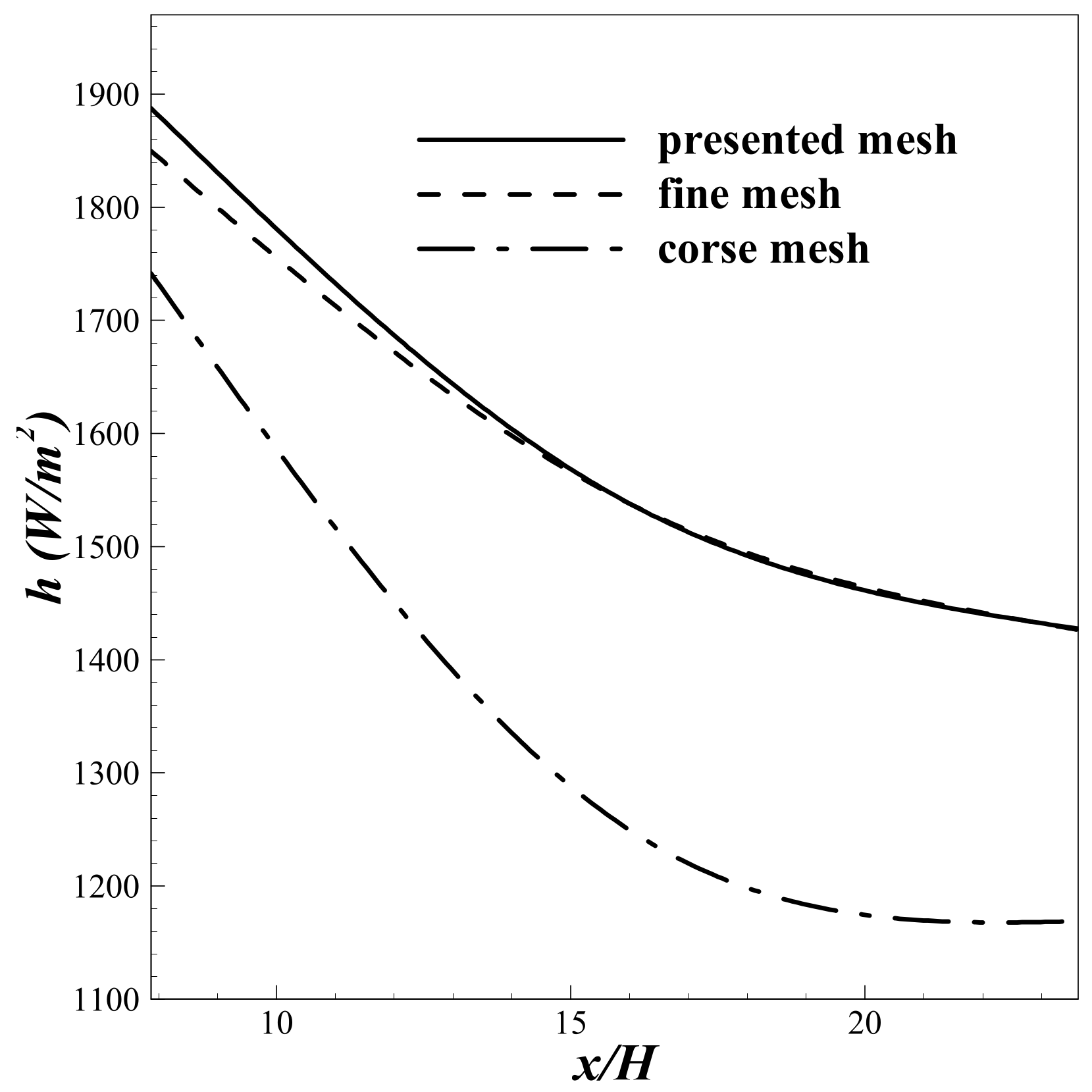
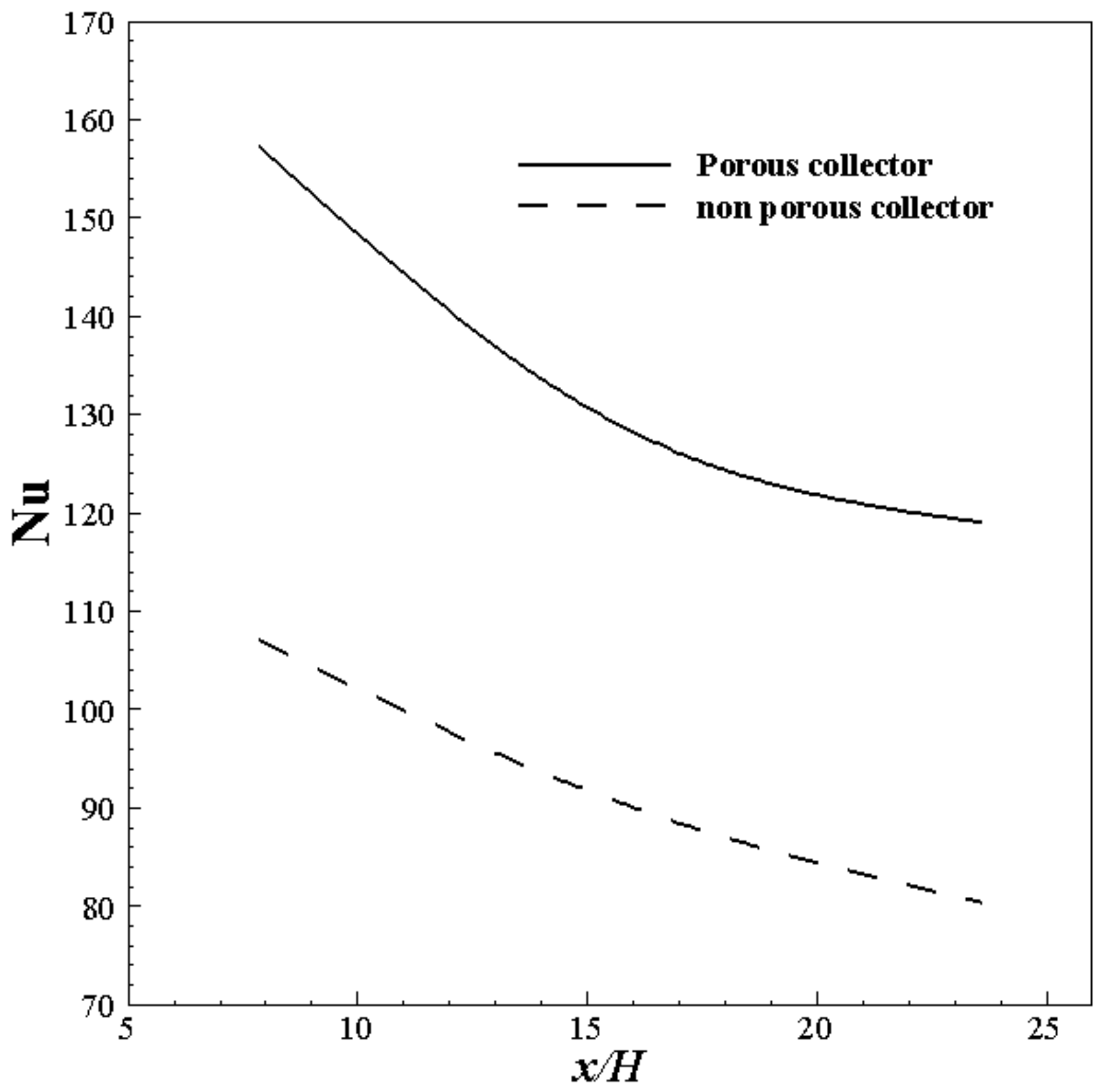
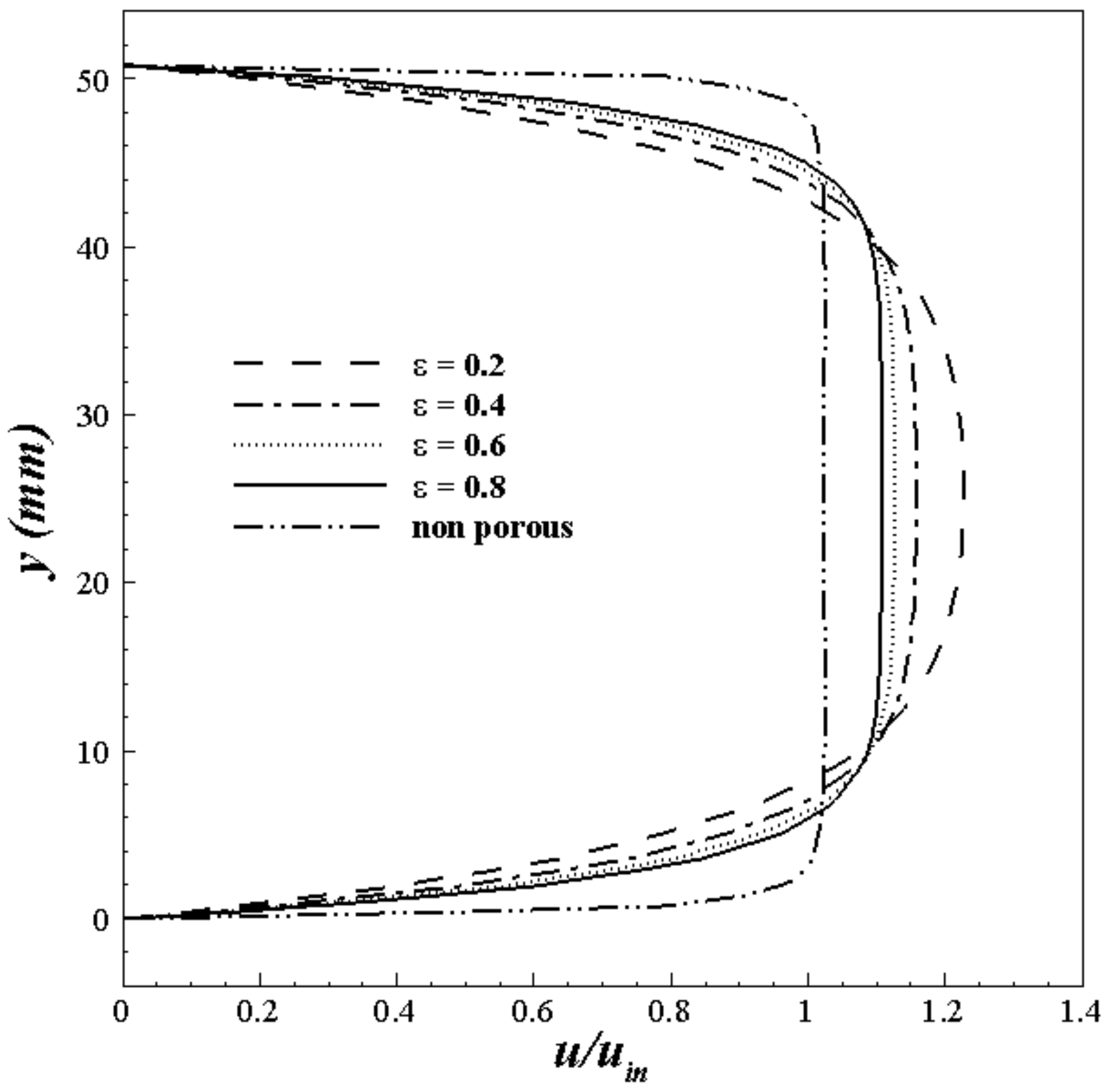
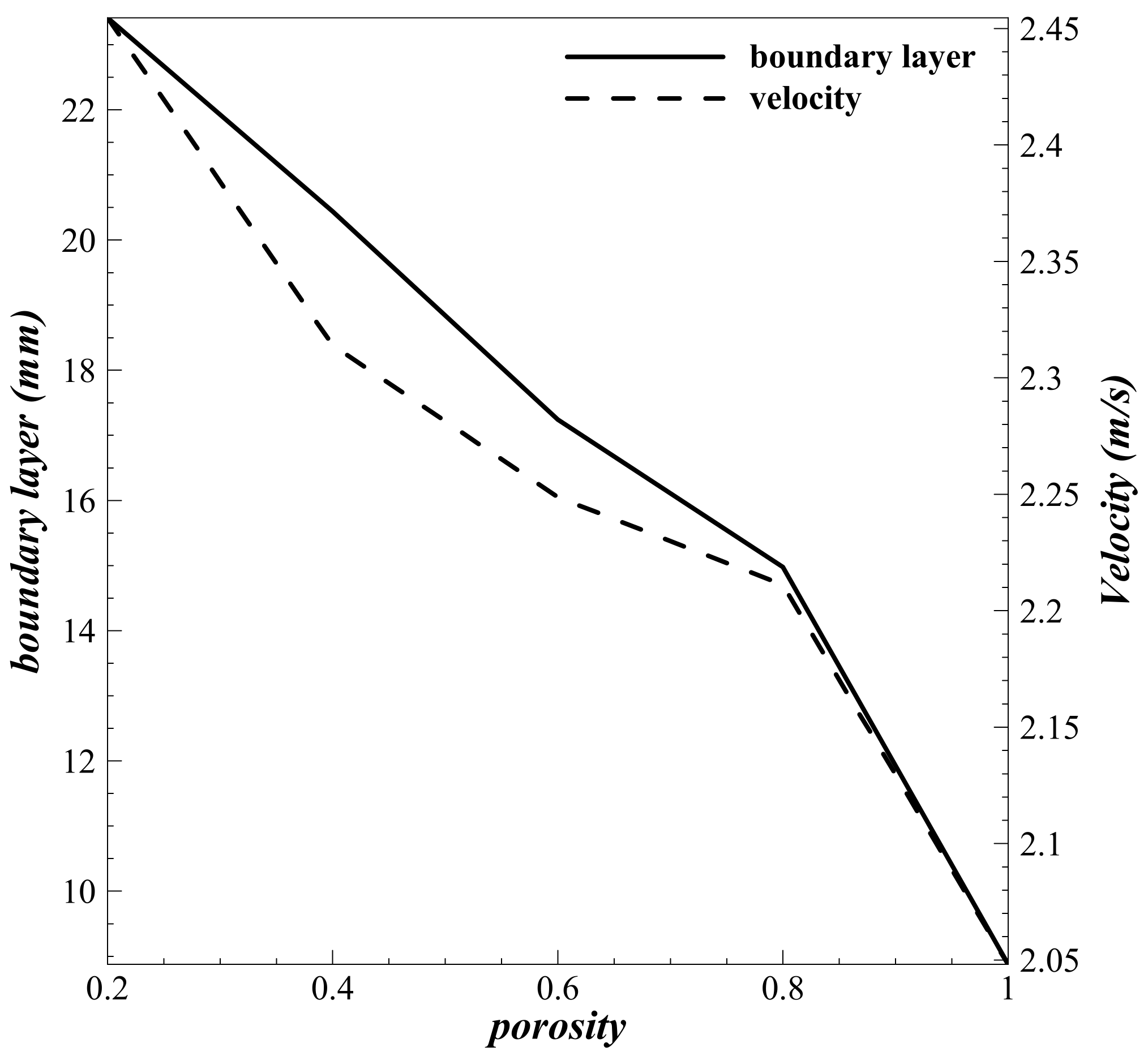



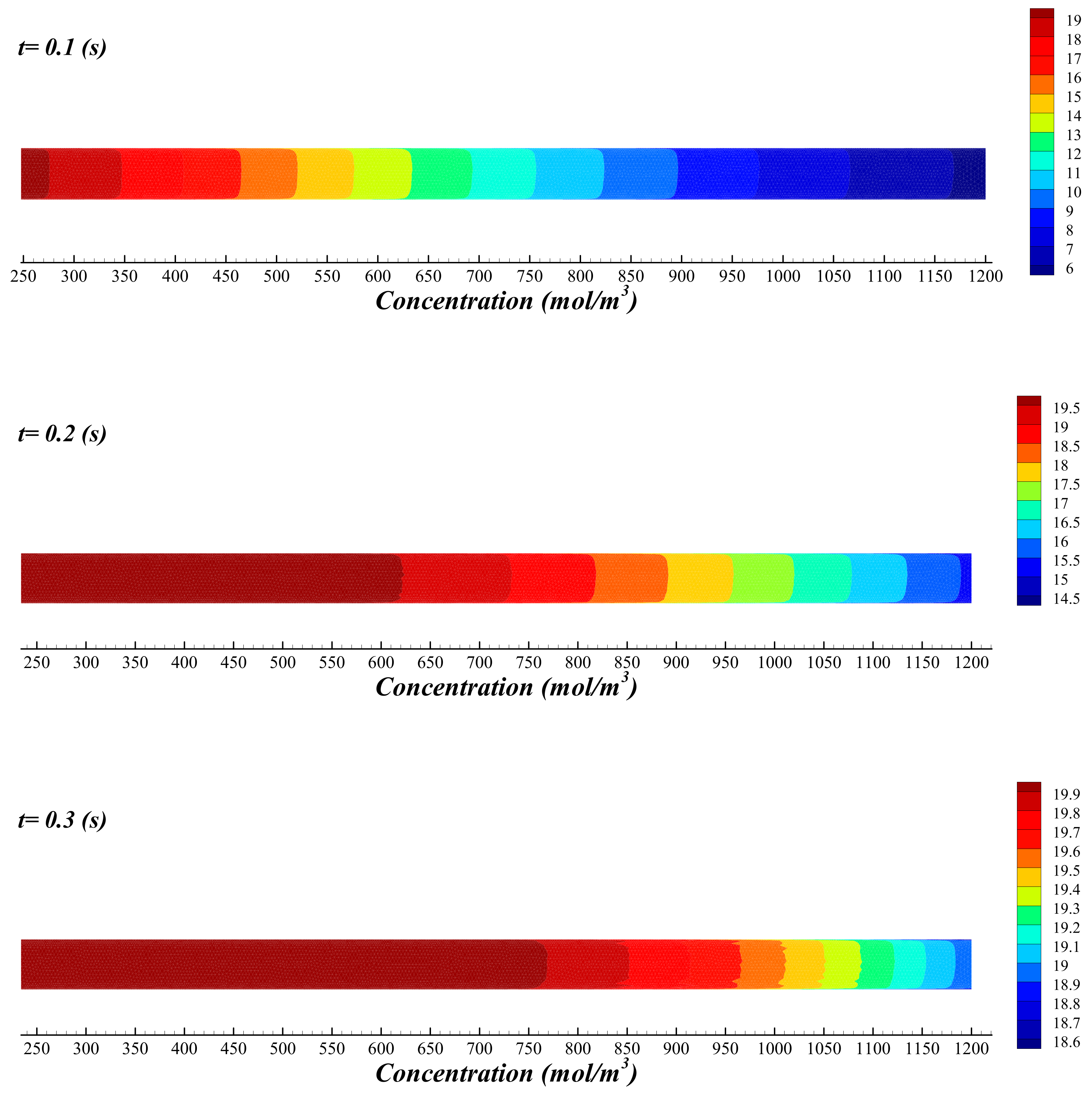
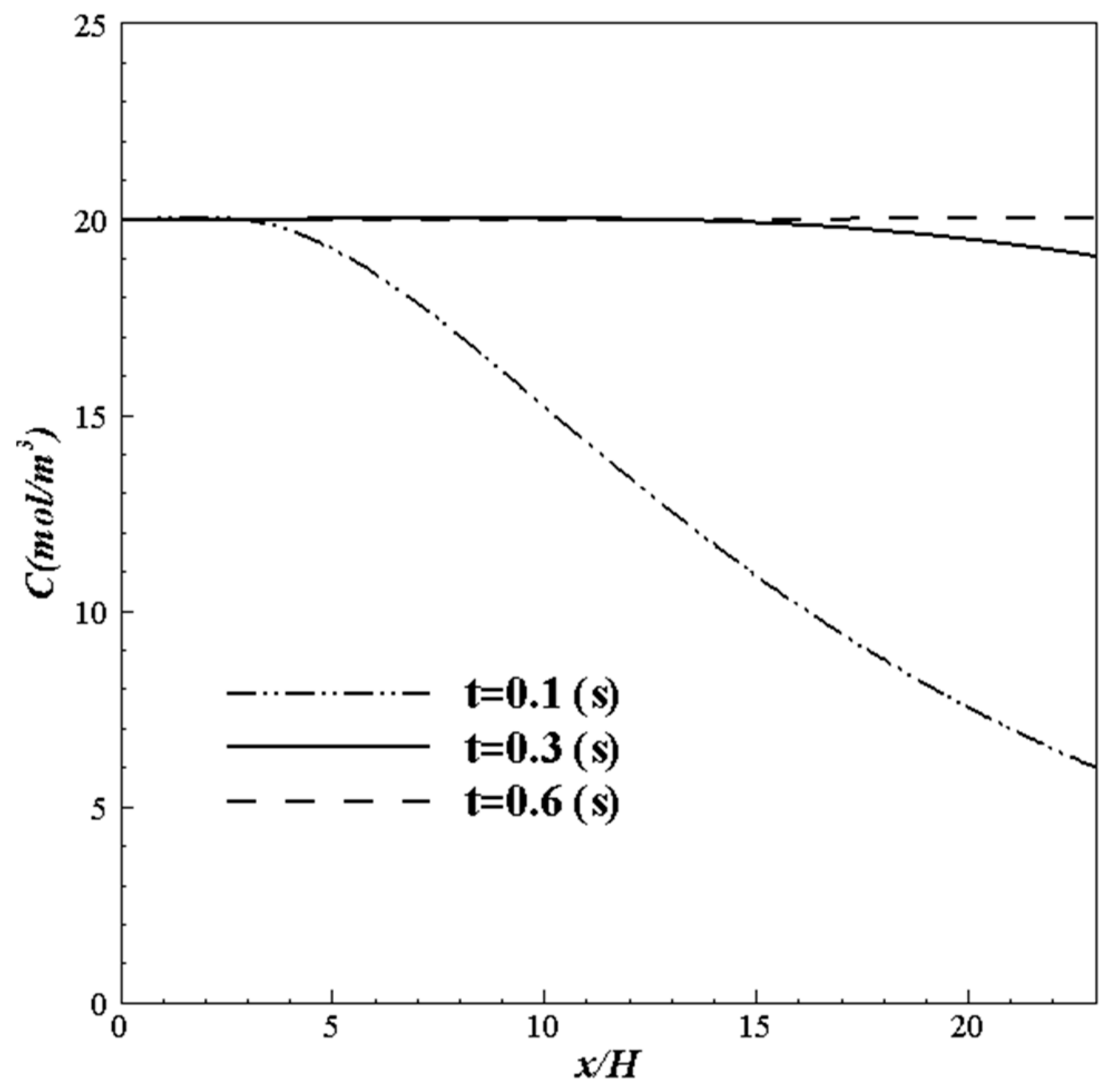
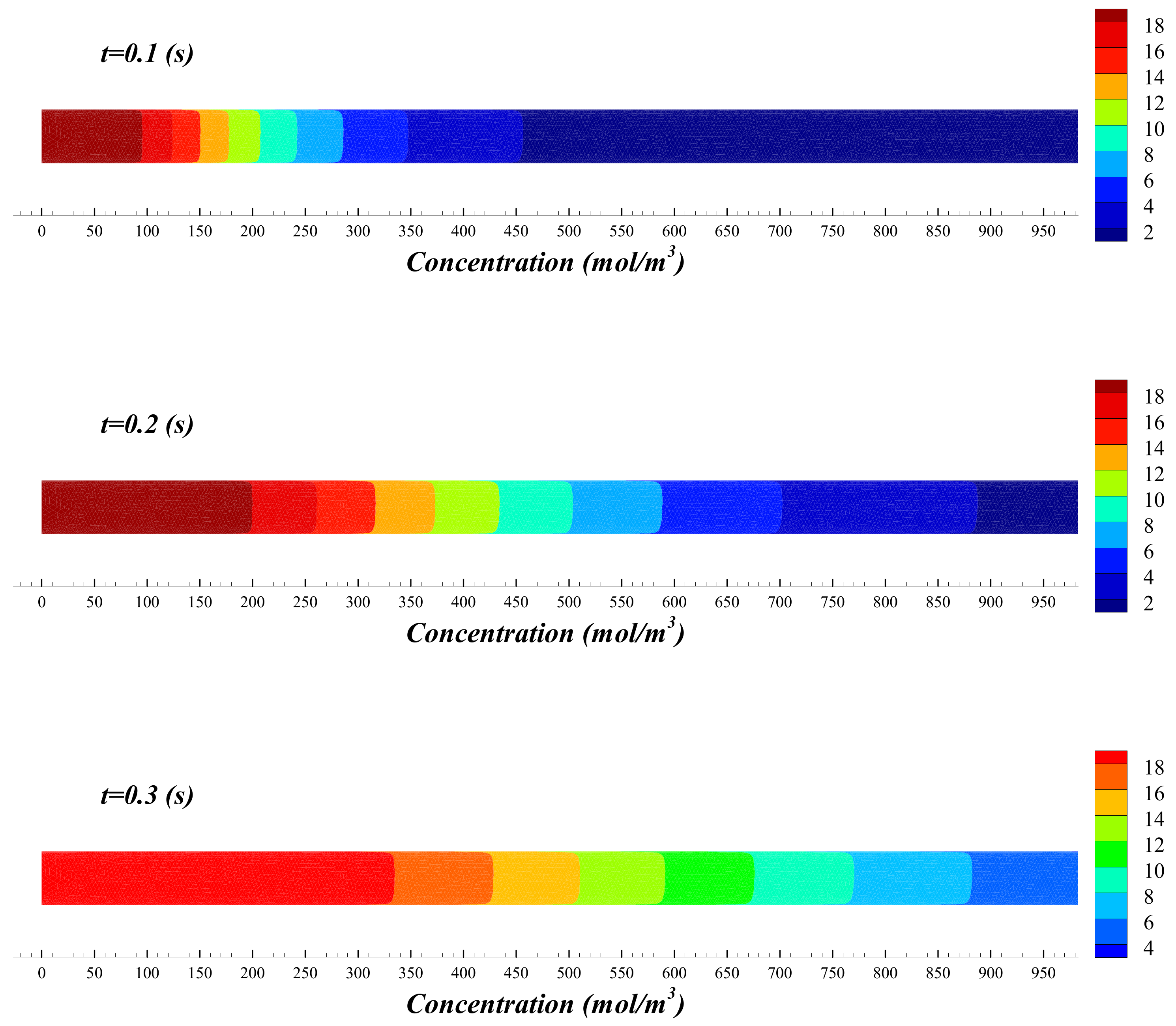

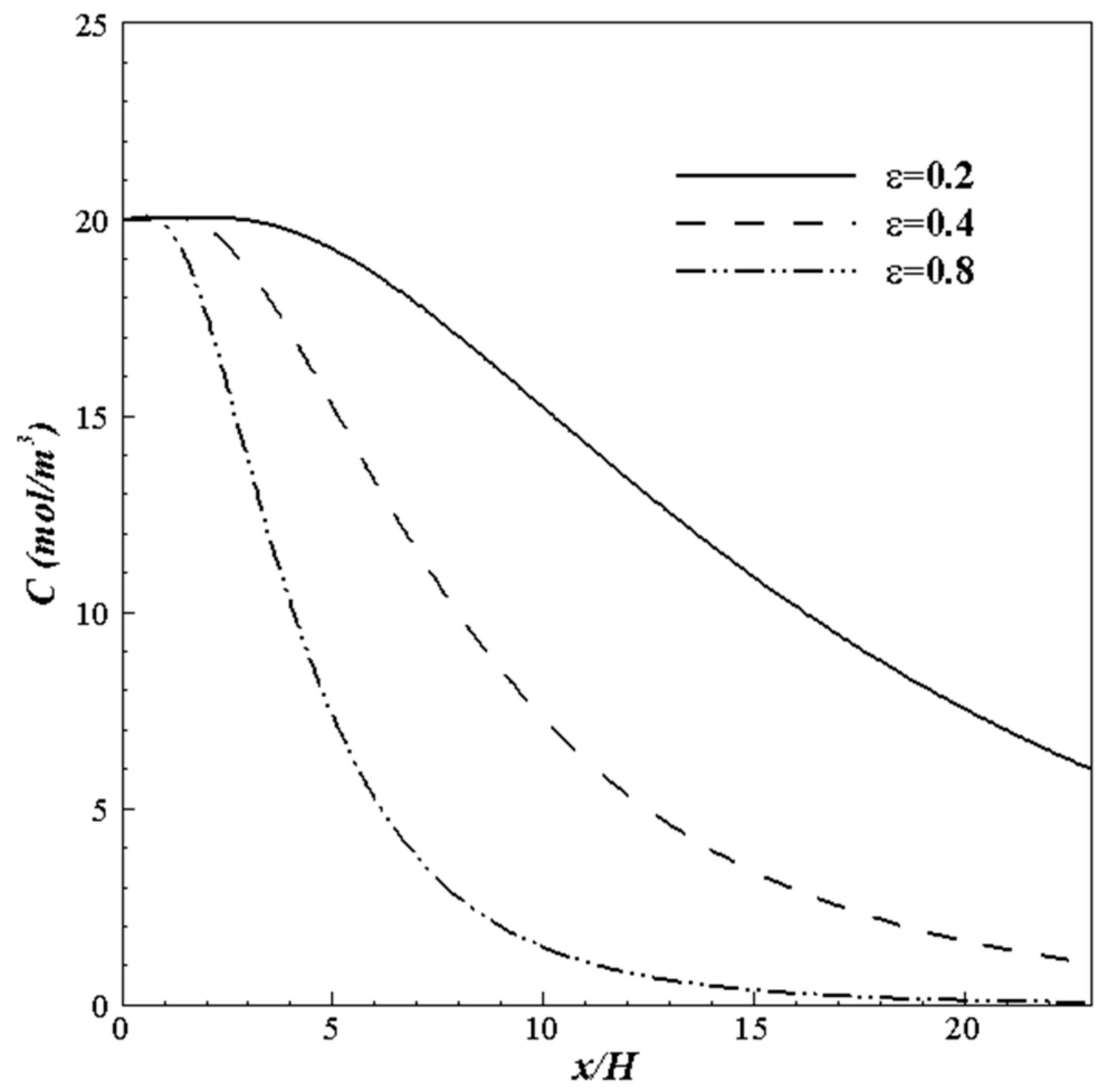
| Collector | ||
|---|---|---|
| Porous collector | 1787.31 | 148.94 |
| Nonporous collector | 1229.40 | 102.45 |
Publisher’s Note: MDPI stays neutral with regard to jurisdictional claims in published maps and institutional affiliations. |
© 2022 by the authors. Licensee MDPI, Basel, Switzerland. This article is an open access article distributed under the terms and conditions of the Creative Commons Attribution (CC BY) license (https://creativecommons.org/licenses/by/4.0/).
Share and Cite
Rezapour, M.; Fanaee, S.A.; Ghodrat, M. Developed Brinkman Model into a Porous Collector for Solar Energy Applications with a Single-Phase Flow. Energies 2022, 15, 9499. https://doi.org/10.3390/en15249499
Rezapour M, Fanaee SA, Ghodrat M. Developed Brinkman Model into a Porous Collector for Solar Energy Applications with a Single-Phase Flow. Energies. 2022; 15(24):9499. https://doi.org/10.3390/en15249499
Chicago/Turabian StyleRezapour, Mojtaba, Sayyed Aboozar Fanaee, and Maryam Ghodrat. 2022. "Developed Brinkman Model into a Porous Collector for Solar Energy Applications with a Single-Phase Flow" Energies 15, no. 24: 9499. https://doi.org/10.3390/en15249499






